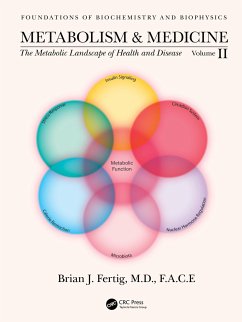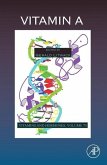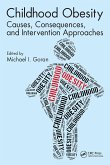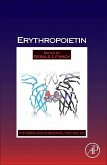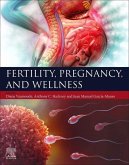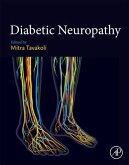Brian Fertig (Hackensack Meridian Health JFK University Hospital)
Metabolism and Medicine
The Metabolic Landscape of Health and Disease (Volume 2)
Brian Fertig (Hackensack Meridian Health JFK University Hospital)
Metabolism and Medicine
The Metabolic Landscape of Health and Disease (Volume 2)
- Gebundenes Buch
- Merkliste
- Auf die Merkliste
- Bewerten Bewerten
- Teilen
- Produkt teilen
- Produkterinnerung
- Produkterinnerung
Chronic disease states of aging should be viewed through the prism of metabolism and biophysical processes at all levels of physiological organization present in the human body. This book connects these insights to what causes them to go awry in the context of unhealthy human behaviors and aging, aiming to buttress scientific creativity.
Andere Kunden interessierten sich auch für
![Vitamin a Vitamin a]() Gerald Litwack ( Ed. -in-chief)Vitamin a132,99 €
Gerald Litwack ( Ed. -in-chief)Vitamin a132,99 €![Childhood Obesity Childhood Obesity]() Childhood Obesity66,99 €
Childhood Obesity66,99 €![Erythropoietin Erythropoietin]() Erythropoietin110,99 €
Erythropoietin110,99 €![Fertility, Pregnancy, and Wellness Fertility, Pregnancy, and Wellness]() Fertility, Pregnancy, and Wellness120,99 €
Fertility, Pregnancy, and Wellness120,99 €![Diabetic Neuropathy Diabetic Neuropathy]() Diabetic Neuropathy140,99 €
Diabetic Neuropathy140,99 €![Epidemiology of Diabetes Epidemiology of Diabetes]() Moini, Jahangir, MD, MPH (Retired Professor of Science and E HealthEpidemiology of Diabetes120,99 €
Moini, Jahangir, MD, MPH (Retired Professor of Science and E HealthEpidemiology of Diabetes120,99 €![Endocrine Disruption and Human Health Endocrine Disruption and Human Health]() Endocrine Disruption and Human Health120,99 €
Endocrine Disruption and Human Health120,99 €-
-
-
Chronic disease states of aging should be viewed through the prism of metabolism and biophysical processes at all levels of physiological organization present in the human body. This book connects these insights to what causes them to go awry in the context of unhealthy human behaviors and aging, aiming to buttress scientific creativity.
Produktdetails
- Produktdetails
- Foundations of Biochemistry and Biophysics
- Verlag: Taylor & Francis Ltd
- Seitenzahl: 426
- Erscheinungstermin: 26. Januar 2022
- Englisch
- Abmessung: 279mm x 216mm x 25mm
- Gewicht: 1340g
- ISBN-13: 9780367699925
- ISBN-10: 0367699923
- Artikelnr.: 62275142
- Foundations of Biochemistry and Biophysics
- Verlag: Taylor & Francis Ltd
- Seitenzahl: 426
- Erscheinungstermin: 26. Januar 2022
- Englisch
- Abmessung: 279mm x 216mm x 25mm
- Gewicht: 1340g
- ISBN-13: 9780367699925
- ISBN-10: 0367699923
- Artikelnr.: 62275142
Brian J Fertig, M.D., F.A.C.E., is the Founder and President of the Diabetes & Osteoporosis Center in Piscataway, New Jersey (https://siomar2.wixsite.com/diabandosteocenter), established in1994. Dr. Fertig's experience in diabetes, endocrinology and metabolism, including internship, residency, fellowship, and private practice, spans a period of 34 years. Dr. Fertig is also an Associate Professor at Robert Wood Johnson Medical School and the Chairman of the Department of Diabetes & Endocrinology at Hackensack Meridian Health-JFK University Medical Center. His passion for patient care and for finding the root problems of disease was his motivation and purpose for writing a two volume book series titled Metabolism and Medicine. On his exploratory journey, Dr. Fertig discovered modern conceptual tools to improve the problem-solving skill sets of great utility for him, his practitioner colleagues, and the next generation of healthcare providers. His genuine concern for the future of medical student education is one of the main factors that motivated him to write this book. Additionally, he is also concerned with the need for interdisciplinary expertise to augment the execution of patient care, but particularly in light of an expanding reliance on Nurse Practitioners and Physician Assistants. His philosophy is based on the concept that the greater the network of interdisciplinary scientific and clinical expertise, the greater the collective skill set and hence the benefit to the patient. The ever-increasing use of bioinformatics paves the way toward personalized-scale medicine. However, the way forward for medicine should also include skillful adaptation of methods developed in physics, which will allow quantification of therapeutic solutions with unprecedented precision. Since physics has a tendency to generalize empirical observations to formulate laws of nature while biology takes pains to tease out detailed specificities, the marriage of the two fields promises the most enlightened future direction for medicine as both an art and a science.
Contents
Prologue...................................................................................................................................................
xv
Acknowledgments.....................................................................................................................................xvii
Author........................................................................................................................................................xxi
Personal
Statements...................................................................................................................................xxiii
1. Introduction to Metabolism: A New Model for
Medicine..................................................................
1
2. The Stress Response: From Health to
Disease...................................................................................
49
3. Nuclear Hormone Receptors: Mediators of Dynamic (Patho)physiological
Responses................. 105
4. The Biology of Time: How Molecular Clocks Make Living Cells
Tick...............................................131
5. Calorie Restriction, Intermittent Fasting, Ketogenic Fasting, and
Time-Restricted Feeding .........191
6. The Microbiota in Symbiotic Entanglement with Human
Metabolism................................................ 225
7. The Role of Insulin Resistance in Metabolic
Disease..............................................................................
275
8. Mitochondrial Function and Dysfunction and Insulin
Resistance......................................................... 323
9. Chronic Diseases of Aging as Metabolic
Disorders..................................................................................
355
Epilogue
............................................................................................................................................................413
Index..................................................................................................................................................................417
Prologue...................................................................................................................................................
xv
Acknowledgments.....................................................................................................................................xvii
Author........................................................................................................................................................xxi
Personal
Statements...................................................................................................................................xxiii
1. Introduction to Metabolism: A New Model for
Medicine..................................................................
1
2. The Stress Response: From Health to
Disease...................................................................................
49
3. Nuclear Hormone Receptors: Mediators of Dynamic (Patho)physiological
Responses................. 105
4. The Biology of Time: How Molecular Clocks Make Living Cells
Tick...............................................131
5. Calorie Restriction, Intermittent Fasting, Ketogenic Fasting, and
Time-Restricted Feeding .........191
6. The Microbiota in Symbiotic Entanglement with Human
Metabolism................................................ 225
7. The Role of Insulin Resistance in Metabolic
Disease..............................................................................
275
8. Mitochondrial Function and Dysfunction and Insulin
Resistance......................................................... 323
9. Chronic Diseases of Aging as Metabolic
Disorders..................................................................................
355
Epilogue
............................................................................................................................................................413
Index..................................................................................................................................................................417
Contents
Prologue...................................................................................................................................................
xv
Acknowledgments.....................................................................................................................................xvii
Author........................................................................................................................................................xxi
Personal
Statements...................................................................................................................................xxiii
1. Introduction to Metabolism: A New Model for
Medicine..................................................................
1
2. The Stress Response: From Health to
Disease...................................................................................
49
3. Nuclear Hormone Receptors: Mediators of Dynamic (Patho)physiological
Responses................. 105
4. The Biology of Time: How Molecular Clocks Make Living Cells
Tick...............................................131
5. Calorie Restriction, Intermittent Fasting, Ketogenic Fasting, and
Time-Restricted Feeding .........191
6. The Microbiota in Symbiotic Entanglement with Human
Metabolism................................................ 225
7. The Role of Insulin Resistance in Metabolic
Disease..............................................................................
275
8. Mitochondrial Function and Dysfunction and Insulin
Resistance......................................................... 323
9. Chronic Diseases of Aging as Metabolic
Disorders..................................................................................
355
Epilogue
............................................................................................................................................................413
Index..................................................................................................................................................................417
Prologue...................................................................................................................................................
xv
Acknowledgments.....................................................................................................................................xvii
Author........................................................................................................................................................xxi
Personal
Statements...................................................................................................................................xxiii
1. Introduction to Metabolism: A New Model for
Medicine..................................................................
1
2. The Stress Response: From Health to
Disease...................................................................................
49
3. Nuclear Hormone Receptors: Mediators of Dynamic (Patho)physiological
Responses................. 105
4. The Biology of Time: How Molecular Clocks Make Living Cells
Tick...............................................131
5. Calorie Restriction, Intermittent Fasting, Ketogenic Fasting, and
Time-Restricted Feeding .........191
6. The Microbiota in Symbiotic Entanglement with Human
Metabolism................................................ 225
7. The Role of Insulin Resistance in Metabolic
Disease..............................................................................
275
8. Mitochondrial Function and Dysfunction and Insulin
Resistance......................................................... 323
9. Chronic Diseases of Aging as Metabolic
Disorders..................................................................................
355
Epilogue
............................................................................................................................................................413
Index..................................................................................................................................................................417

